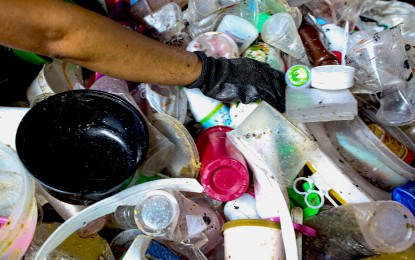
(PNA file photo)
MANILA – About 12 million pieces of marine litter were found along the coastline of Manila Bay, of which 90 percent or 11 million were plastic.
In a press conference on Thursday, toxic-free and zero-waste watchdog group Ecowaste Coalition reported that a new study made in partnership with the Korean International Cooperation Agency (KOICA), De LaSalle University-Dasmarinas, and the Department of Environment and Natural Resources shows that most plastic litters collected along Manila Bay were hard film and other types of plastics, but the majority are single-use plastics (SUPs).
“We are alarmed that marine litter, mostly from single-use plastics, are stuck in the coastal areas of Manila Bay. Studies show that single-use plastics pose a grave danger to vulnerable communities and are an escalating crisis for the environment, health, and climate. The study shows that we have a long way to go to eliminate the ubiquitous problem of single-use plastics and marine litter as a whole,” Von Vladimir Defuntorum of Ecowaste Coalition said.
During the briefing, Ecowaste Coalition presented the study “Marine Litter Monitoring Survey in Manila Bay: Year 1 (2023)” report, which was a component of the Enhancement of Marine Litter Management in Manila Bay, Philippines (2021-2025) project.
Ten coastal areas in the National Capital Region, Region 3, and Region 4A were covered by the study that aims to classify marine litter, as well as compare marine litter during dry and wet months, and identify top items of marine litter based on actual counts.
Ecowaste Coalition said that the study confirms that “sachet economy” is the norm in the country as most Filipinos are highly dependent on single-use plastics such as single-use utensils, sachets, and wrappers.
Various studies have already shown that SUPs are destructive not only to the environment but to human health as well.
This is because as plastics break down and become microplastics and nanoplastics, they find their way into the food people eat leading to a range of toxicological effects, including reproductive abnormalities, oxidative stress, and gastrointestinal dysfunction.
Manila Bay is bordered by the coastal cities of the NCR which include Manila, Pasay, Paranaque, Las Piñas, and Navotas, and the coastal provinces of Bataan, Pampanga, Bulacan in Region 3, and Cavite in Region 4A.
It is also intersected by the seven major rivers, which are the major sources of marine pollution in the bay.
Meanwhile, Yuna Lee, Manager of International Cooperation Team, Our Sea of East Asia Network, said the new study could serve as baseline data for concerned sectors.
“With this baseline study, we are optimistic that it will contribute to the deepening of our understanding of the marine litter problem. We hope that this study will lead to the execution of an impactful cost-effective policies and management practices towards prevention and reduction of marine pollution in Manila Bay by urging a multi-sectoral initiative to strengthen the environmental protection system in the Bay, ” she said. (PNA)
